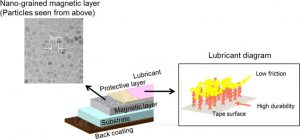[ad_1]
“The resulting technology can support approximately 330TB per data cartridge, whereas conventional technology can only handle 15TB per data cartridge”, said Sony (see footnote).
Behind the announcement is Sony’s lubricated magnetic tape technology with IBM Research Zurich’s newly developed write/read heads, servo control and signal-processing algorithms.
Lubricant allows the gap between tape and magnetic head to be reduced without excessive friction, and bonds to the magnetic layer of the tape.
The tape has a ‘nano-grained’ magnetic (see photo). “Conventionally, a common problem is non-uniform crystalline orientation and disparities in grain sizes due to impurity gas generated from the surface of equipment during magnetic layer formation,” said Sony. “Processing technology that reduces impurity gas is used in conjunction with sputter deposition to form a magnetic layer with an average grain size of 7nm, thereby resulting in extended tape length.” – more than 1,000m of tape fits in a cartridge.
Why magnetic tape?
Cloud computing, big data, and backing up data for reliable recovery require vast amounts of storage. According to Sony, magnetic tape advantages include: long storage life, low power consumption, low cost, and saving space.
The technology behind the storage record was described at the 28th Magnetic Recording Conference at the Tsukuba International Conference Center in Japan.
Footnote: Hats off to Sony and IBM here for showing their workings:
The latest enterprise tape drive example is the IBM TS1155, which stores at 9.6 Gb/in2. The 330TB figure assumes the same format overheads as the TS1155 JD cartridge (109 x 125 x 24.5mm) which can hold 15TB (uncompressed), and a 6.4% increase in tape length enabled by the thinner demo tape.
[ad_2]
Source link

